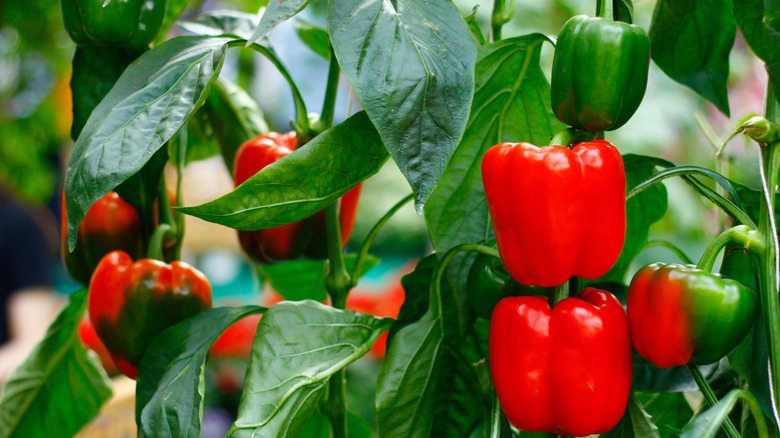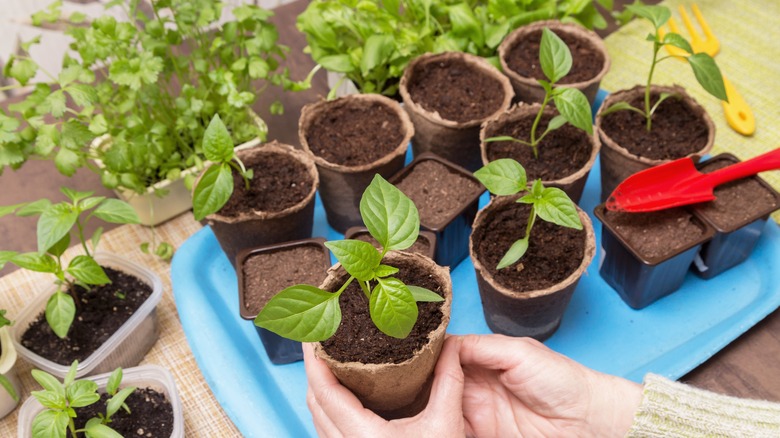The Best Way To Transplant Pepper Plants To Ensure A Healthy Harvest
If you are growing your own pepper plants from seed and starting them off in tiny seedling cells, it's important to remember to transplant them early. Transplanting involves swapping out the initial container for a bigger one in order to give the roots more room to spread out because they have filled the space in the cell. This encourages growth and the potential for maturity — leading to bigger leaves for better photosynthesis, more capacity for the plant to make food, and results in bigger fruit and vegetables for you to harvest!
When the seedling begins to produce their third set of true leaves — about 3 to 4 weeks after sprouting — they should be ready for transplanting. True leaves come after the first set of leaves, called seed leaves. Seed leaves are actually part of the plant embryo, and their main function is to store food until the true leaves can take over and perform photosynthesis. Then, the seed leaves drop off. You may need to wait a little longer depending on the type of peppers you are growing, especially with the spicy pepper varieties, which grow more slowly. Just use your judgment, and if they seem a bit on the small side, an extra week won't hurt.
How to transplant your pepper plants
To transplant your pepper seedlings. You will need freshly cleaned 3 ½-inch plastic pots with good drainage and a quality commercial growing compost, free of 'damping off' organisms. Damping off is a soil-borne fungal disease that causes the stems of seedlings to rot. You'll also need a large mixing container to pre-moisten the soil — why not invest in a 12-inch pot that will also house your fully matured plant later on?
First, fill the mixing container with enough soil for your new pots. Add filtered water slowly and mix as you go to pre-moisten. The soil is ready when it sticks together and can be squeezed without dripping excess water. Add more dry soil if it gets too wet. Next, fill your pots three-quarters full with moist soil, compressing until you feel some resistance, then add a little more. Make a hole in the middle of each pot for the seedlings using your finger, then gently massage the outside of your seedling cell containers to loosen the root balls. Flip the tray and very carefully pull the seedlings out one by one by their stems. Pop the root balls into the holes you made in the new pots, centering the stems, and add more soil around the edges without burying any of the stems, as this could lead to rot. Compress the soil around each pepper plant to add stability. And finally, give them all a quick drink of water.
Why transplant pepper plants for a healthy harvest?
Planting your pepper seeds in starter cells and failing to transplant the seedlings promptly could stunt the plant's overall growth. This is because the roots will have limited space to grow. If the roots can't spread out and grow into a larger area of soil, they won't be able to take in enough nutrients, which means your pepper plant won't be able to reach its full potential.
What's more, if you don't free your plant from the tiny seedling cell at the right time, the roots will become squashed and root-bound. The longer you leave it, the worse the overall impact on your plant. The disturbance of transplanting a root bound seedling could shock the plant, but worse, since the roots will be forced to grow around and round the inside of the pot, they could end up strangling the seedling if left to continue growing like that.
Stunted root growth also leads to stunted leaf growth. If you don't transplant your pepper plant seedlings properly, you may end up with tall and leggy plants that don't have many full leaves. Fully mature and healthy leaves are essential for a healthy plant to sufficiently photosynthesize and make enough food to grow fruits and vegetables. If you have leggy seedlings, you can add a fan for a few hours each day to mimic their natural outdoor environment and encourage more stocky growth.

